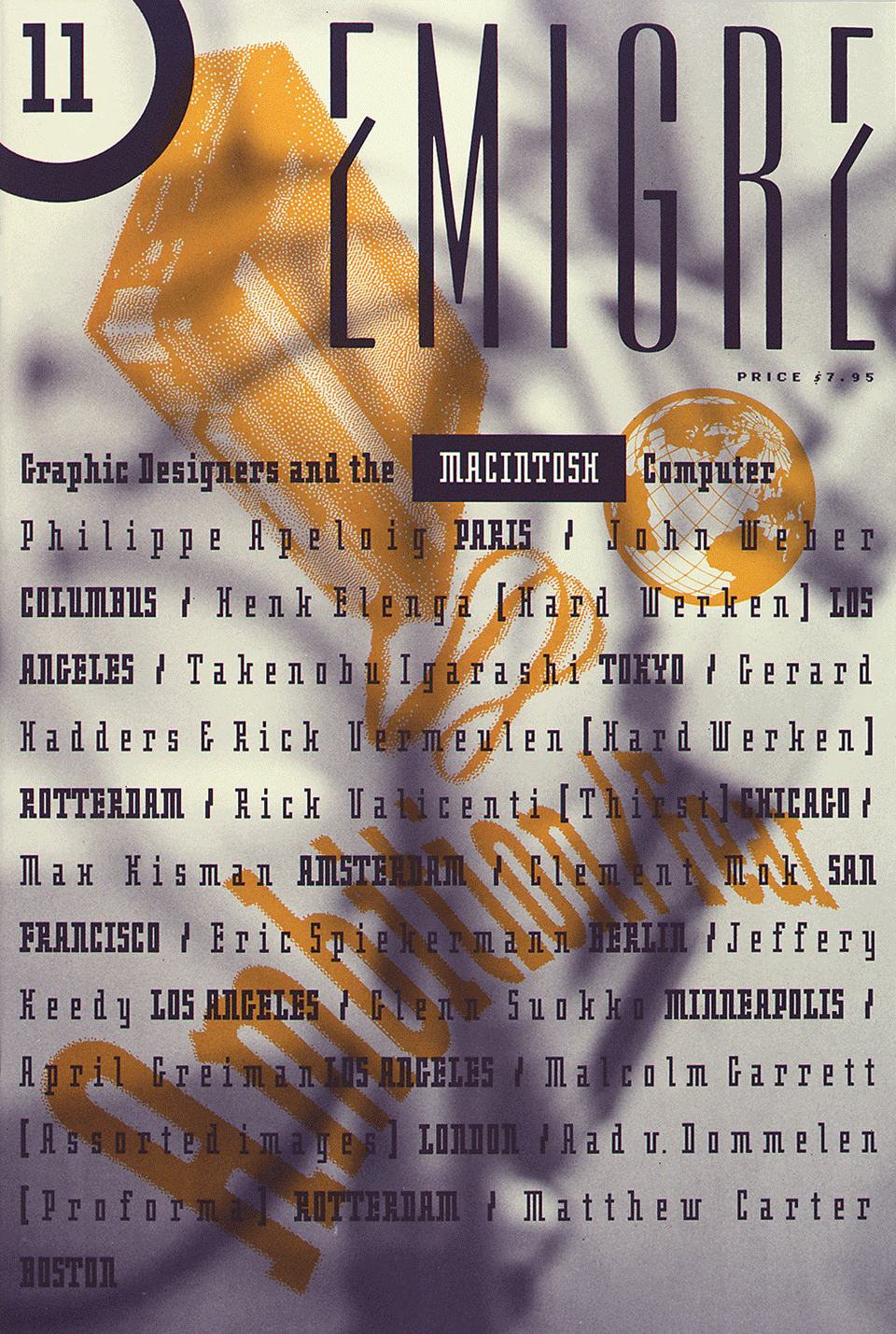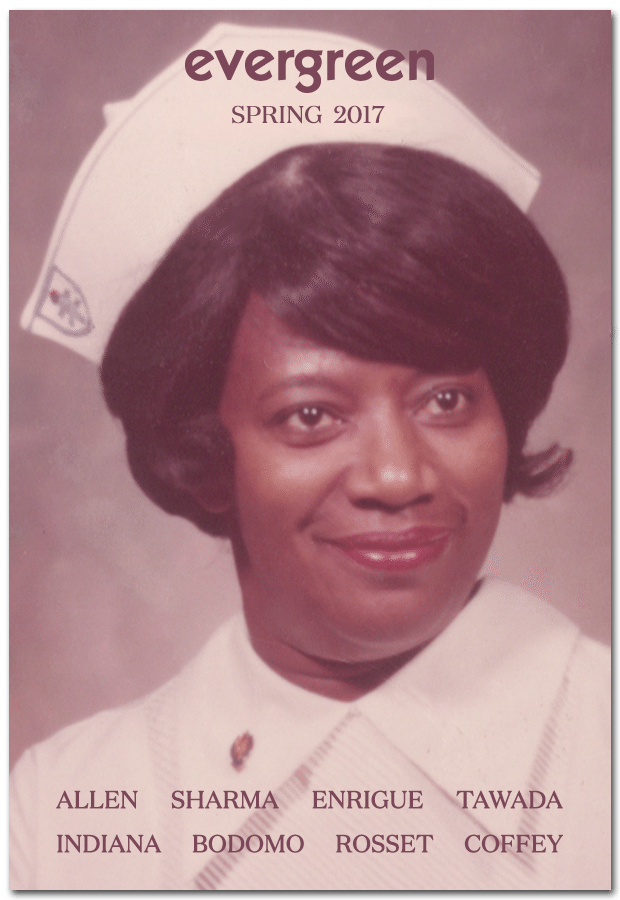Emigre, 11: Graphic Designers and the Macintosh Computer (1989)
Filed under magazine | Tags: · computer graphics, graphic design, typography

“Emigre magazine’s eleventh issue, ‘Ambition/Fear: Graphic Designers and the Macintosh Computer’, contains vivid artifacts of a discipline’s first encounter with digital tools. From the aesthetics of bitmaps to the expressive interventions made possible by new access to typesetting controls, not to mention the self-publishing venture of the magazine itself, this issue combines modernist and postmodern agendas in a model construction of text-based community.”
Release of the digitized issue “coincides with the publication of “Inflection Point” a rigorously researched essay about Emigre #11 by writer/designer Emily McVarish. The essay takes a close look at Emigre #11, analyzing the technical, critical, and cultural production that would shape Emigre as a medium for typographic demonstration and discussion among peers.”
Design and production: Rudy VanderLans
Typeface designs: Zuzana Licko
Publisher Emigre Graphics, Berkeley, CA, 1989
32 pages, 11.25 x 16.75 in
via Letterform Archive
Commentary: Emily McVarnish (2017, 59 pp).
Comment (0)391, 1-19 (1917-1924) [French]
Filed under artist publishing, magazine | Tags: · art, avant-garde, dada, poetry

391 was a Dada magazine edited by Francis Picabia and published between 1917 and 1924 in 19 numbers in Barcelona (nos. 1-4), New York (nos. 5-7), Zürich (no. 8) and Paris (nos. 9-19).
Contributors included Guillaume Apollinaire, Louis Aragon, Walter C. Arensberg, Céline Arnauld, Hans Arp, Pierre Albert-Birot, André Breton, Gabrielle Buffet, Jean Cocteau, Jean Crotti, Robert Desnos, Paul Dermée, Paul Éluard, Albert Gleizes, M. Goth, Max Jacob, M. Laurencin, René Magritte, Pierre de Massot, E.L.T. Mesens, Francis Picabia, Man Ray, Georges Ribemont-Dessaignes, Erik Satie, Walter Serner, Philippe Soupault, Tristan Tzara, Edgard Varèse, Marius de Zayas, a.o.
The issue 12 features Francis Picabia’s “Manifeste Dada” with reproduction of Marcel Duchamp’s L.H.O.O.Q.
Edited and published by Francis Picabia, Barcelona/New York/Zürich/Paris, January 1917-October 1924
Comment (0)Evergreen, 1 (2017)
Filed under fiction, magazine | Tags:

“The Evergreen Review, the feisty independent magazine known as “the heart of the Beats,” returns. The new Evergreen builds on a legacy of searching out the stories that aren’t being told or aren’t being heard: stories that challenge our sensibilities and expand our understanding of the way people actually live in the world and the way their truths can be expressed. Available free of charge online, the magazine features fiction, nonfiction, and poetry from an international array of new and established writers.
Our first issue features work from acclaimed writers such as Jeffery Renard Allen and Gary Indiana; emerging talents such as filmmaker Frances Bodomo, photographer Hadji Johnali, and writer Jade Sharma; and well-known artists in mid-career, including novelists Yoko Tawada and Álvaro Enrigue and painters Joy Garnett and Katie Merz.
Evergreen pushes aesthetic and political boundaries: Bodomo is Ghanaian, Enrigue Mexican, Johnali Iranian, and Tawada Japanese-German. Johnali’s full-sized photographs of Muslim prayer rugs inscribed with wry graffiti challenge notions of piety and identity. Allen’s essay, “Urgently Visible: Why Black Lives Matter,” begins with the assertion “White folks in America are the most dangerous people on earth. No two ways about it.” Gary Indiana’s “Romanian Conversation” centers on the relationship between an American writer and someone who is presumably his paid male companion, as they observe a group of heterosexual prostitutes and their pimps working a street in Romania. And Yoka Tawada’s “Memoirs of a Polar Bear” is just that: the life story of a talking polar bear sent as a gift from the USSR to East Berlin.
Although dedicated to new work, Evergreen cherishes its awe-inspiring past. The debut issue features founding publisher Barney Rosset’s account of the Tropic of Cancer obscenity trials, as well as a nod to one of Evergreen’s most famous alums in “Samuel Beckett Is Closed” by Michael Coffey. Evergreen takes advantage of the possibilities of digital publishing to feature dynamic visuals, including original films like Bodomo’s Boneshaker, the story of an African family looking for a church meeting in the deep South.” (Source)
Publisher Evergreen Review, New York, NY, April 2017
HTML
See also selected back issues of Evergreen Review, 1957-2003.

